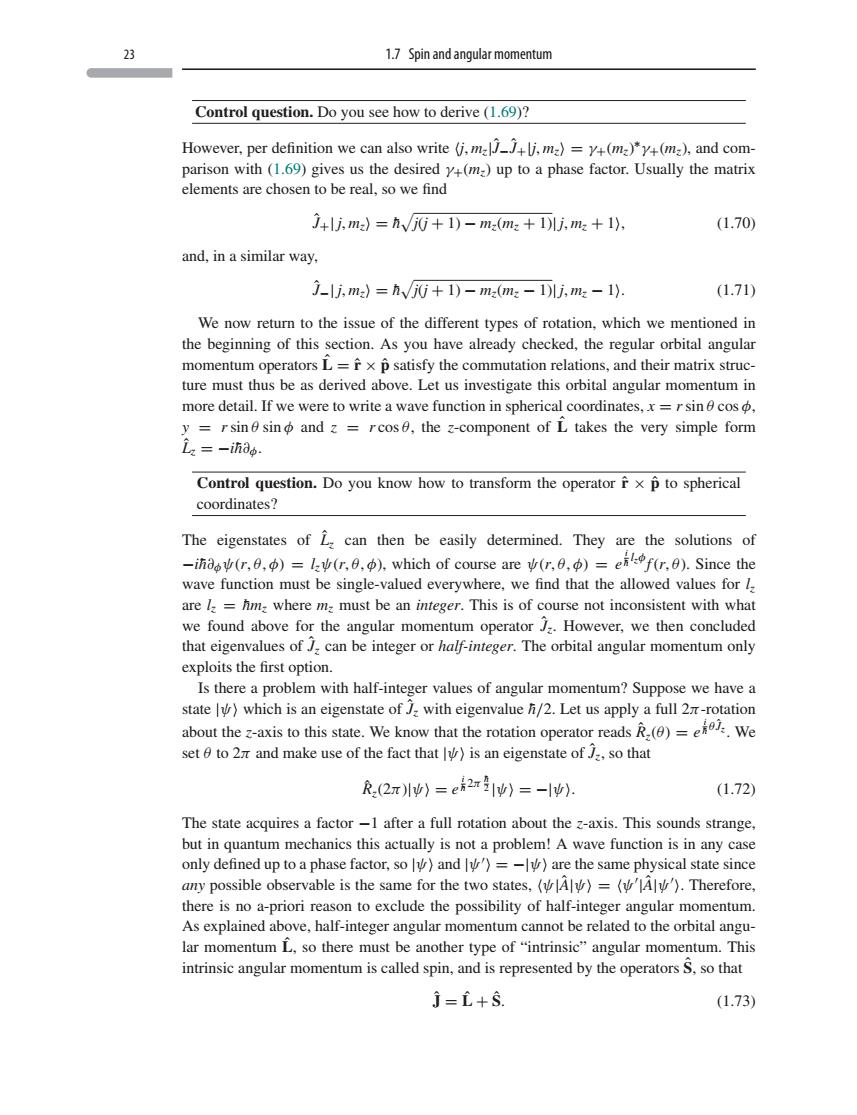正在加载图片...

23 1.7 Spin andangular momentum Control question.Do you see how to derive(1.69)? However.per definition we can also write (j.mm)=y+(m2)) +(m),and com parison with (1.69)gives us the desired y+(m)up to a phase factor.Usually the matrix elements are chosen to be real,so we find J4j,m2)=hvjj+1)-mz(m:+1)lj.m2 +1) (1.70 and,in a similar wav. -j,m)=h0+1)-m(m:-1i,m:-1 (1.71) We now return to the issue of the different types of rotation,which we mentioned in the beginning of this section.As you have already checked.the regular orbital angular erators L=x p satisfy the commutation relations,and their matrix struc- urebe as derived above Let us inveti this obita anurm ntum more detail.If we were to write a wave function in spherical coordinates,=rsin cos y =rsin sin and z=rcose,the z-component of L takes the very simple form L=-indo. Control question.Do you know how to transform the operatorx p to spherical coordinates? The eigenstates of can then be easily determined.They are the solutions of ))which of course are)(r.0).Since the ion must be single-valued everyw for are l=hm:where m:must be an integer.This is of course not inconsistent with wha we found above for the angular momentum operator J.However,we then concluded that eigenvalues of J.can be integer or half-integer.The orbital angular momentum only exploits the first option. Is there a problem with half-i values of a omentum?Supp se we have a about the z-axis to this state.We know that the rotation operator readsR)=eWe set 6 to 2 and make use of the fact that)is an eigenstate of so that R(2rlw)=e2)=-1. (1.72) The state acquires a factor-1 after a full rotation about the z-axis.This sounds strange. but in quantum mechanics this actually is not a problem!A wave function is in any case only defined up to a phase factor.so)and)=)are the same physical state since any possible observable is the same for the two states,(A)=(Aly').Therefore, there is no a-priori reason to exclude the possibility of half-in angular momentum As explained a ve,half-integer angul omentur lar momentumL,so there must be another type of"intrinsic"angular momentum.Thi intrinsic angular momentum is called spin,and is represented by the operators S.so that j=1+s. (1.73) 23 1.7 Spin and angular momentum Control question. Do you see how to derive (1.69)? However, per definition we can also write j, mz|Jˆ−Jˆ+|j, mz = γ+(mz) ∗γ+(mz), and comparison with (1.69) gives us the desired γ+(mz) up to a phase factor. Usually the matrix elements are chosen to be real, so we find Jˆ+| j, mz = h¯
j(j + 1) − mz(mz + 1)| j, mz + 1, (1.70) and, in a similar way, Jˆ−| j, mz = h¯
j(j + 1) − mz(mz − 1)| j, mz − 1. (1.71) We now return to the issue of the different types of rotation, which we mentioned in the beginning of this section. As you have already checked, the regular orbital angular momentum operators Lˆ = rˆ × pˆ satisfy the commutation relations, and their matrix structure must thus be as derived above. Let us investigate this orbital angular momentum in more detail. If we were to write a wave function in spherical coordinates, x = rsin θ cos φ, y = rsin θ sin φ and z = r cos θ, the z-component of Lˆ takes the very simple form Lˆz = −ih¯∂φ. Control question. Do you know how to transform the operator rˆ × pˆ to spherical coordinates? The eigenstates of Lˆz can then be easily determined. They are the solutions of −ih¯∂φψ(r, θ, φ) = lzψ(r, θ, φ), which of course are ψ(r, θ, φ) = e i h¯ lzφf(r, θ). Since the wave function must be single-valued everywhere, we find that the allowed values for lz are lz = hm¯ z where mz must be an integer. This is of course not inconsistent with what we found above for the angular momentum operator Jˆz. However, we then concluded that eigenvalues of Jˆz can be integer or half-integer. The orbital angular momentum only exploits the first option. Is there a problem with half-integer values of angular momentum? Suppose we have a state |ψ which is an eigenstate of Jˆz with eigenvalue h¯/2. Let us apply a full 2π-rotation about the z-axis to this state. We know that the rotation operator reads Rˆz(θ) = e i h¯ θJˆz . We set θ to 2π and make use of the fact that |ψ is an eigenstate of Jˆz, so that Rˆz(2π)|ψ = e i h¯ 2π h¯ 2 |ψ = −|ψ. (1.72) The state acquires a factor −1 after a full rotation about the z-axis. This sounds strange, but in quantum mechanics this actually is not a problem! A wave function is in any case only defined up to a phase factor, so |ψ and |ψ = −|ψ are the same physical state since any possible observable is the same for the two states, ψ|Aˆ|ψ=ψ |Aˆ|ψ . Therefore, there is no a-priori reason to exclude the possibility of half-integer angular momentum. As explained above, half-integer angular momentum cannot be related to the orbital angular momentum Lˆ , so there must be another type of “intrinsic” angular momentum. This intrinsic angular momentum is called spin, and is represented by the operators Sˆ, so that Jˆ = Lˆ + Sˆ. (1.73)